Hubble's deep field images of the early universe are postcards from billions of years ago
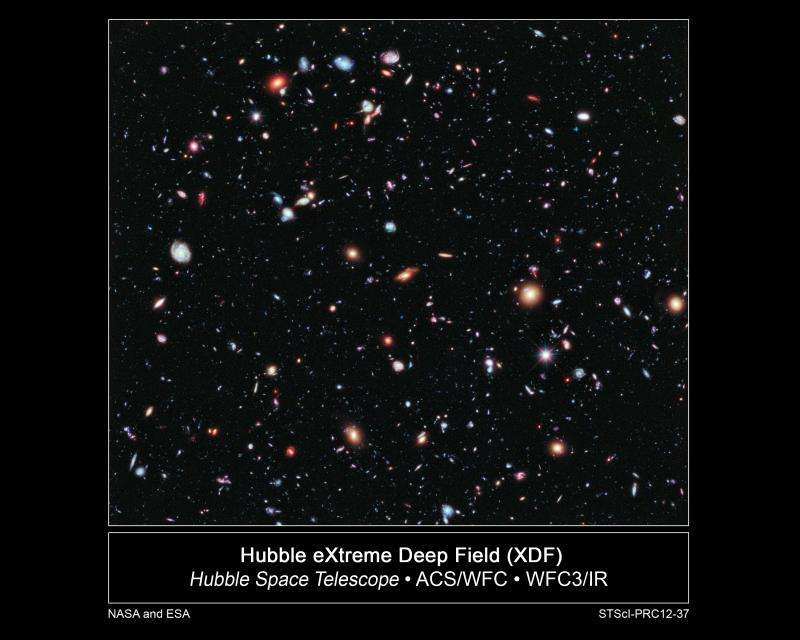
This insignificant patch of sky in the fairly obscure constellation of Fornax is the setting for one of the most remarkable images ever captured. Although only a fraction of the full moon in size, this image traces thousands of distant galaxies to the edge of the observable universe.
The Hubble Space Telescope began observing "deep fields" in 1995. The idea was not new – astronomers have always tried to take longer photographic captures that draw in more light to reveal ever more faint and distant objects. Observing more distant galaxies sheds light on how they form, and how their shapes and sizes change over time. Hubble's key advantage is that, floating in orbit, it's unaffected by the blurring effect of the atmosphere and so can provide images of far superior resolution than ground-based telescopes.
Careful planning was required for the deep field images. An "empty" piece of sky was needed that contained no bright sources of visible light that might drown out fainter objects. There could also be no bright sources at other wavelengths, such as X-ray or radio waves where complementary supporting observations might be made. The direction chosen was away from the millions of faint stars and dust of the plane of our own galaxy, the Milky Way.
This was not without risk, however. Hubble was, and still is, a hugely popular, world-class research facility. It is typical that demand for Hubble's instruments outstrips availability by six or seven times. There was always the possibility that the 10 days observation required might reveal the carefully-chosen blank part of the sky to be just that: blank.
Even dark skies are filled with stars
Instead the results of the first Hubble Deep Field image were breathtaking. After stitching together the composite images and careful processing, the final image revealed around 3,000 galaxies, most of which would otherwise have never been seen. This success triggered plans for further "deep field" images.
A southern-hemisphere counterpart followed in 1998, and after a powerful instrument upgrade in 2002, the Hubble Ultra Deep Field images were taken in 2004.
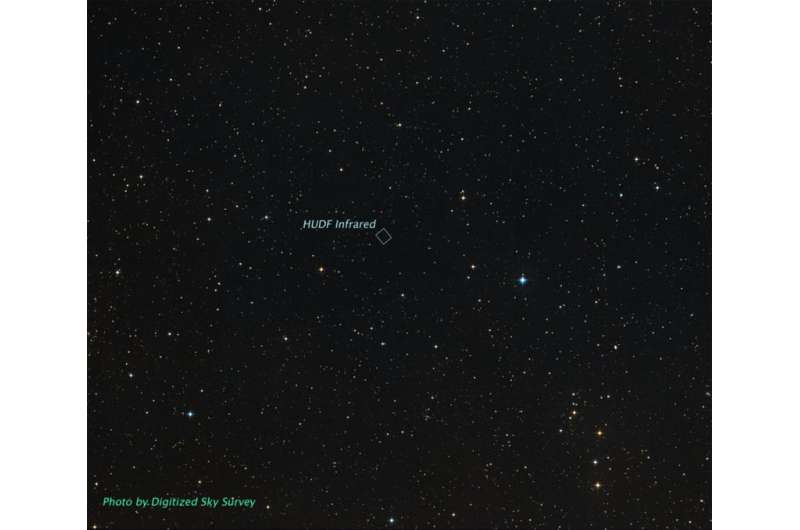
Finally, advances in data processing techniques, some new infrared data and more images of Ultra Deep Field area were in 2012 combined to create the Hubble eXtreme Deep Field (HXDF), the main image above, and the same image with ultraviolet included, below – humanity's most sensitive images of the cosmos ever taken.
Looking out at the cosmos
The HXDF image is the result of 2m seconds (more than 23 days) of exposure time taken over the course of 2,963 images. The captures that make up the composite image are sensitive to light from the ultraviolet to the near-infrared spectrum, which are used in the processing to create the colours visible. The faintest objects in the HXDF, barely visible on screen, are a remarkable ten-billionth the brightness of the faintest star visible to the naked eye.
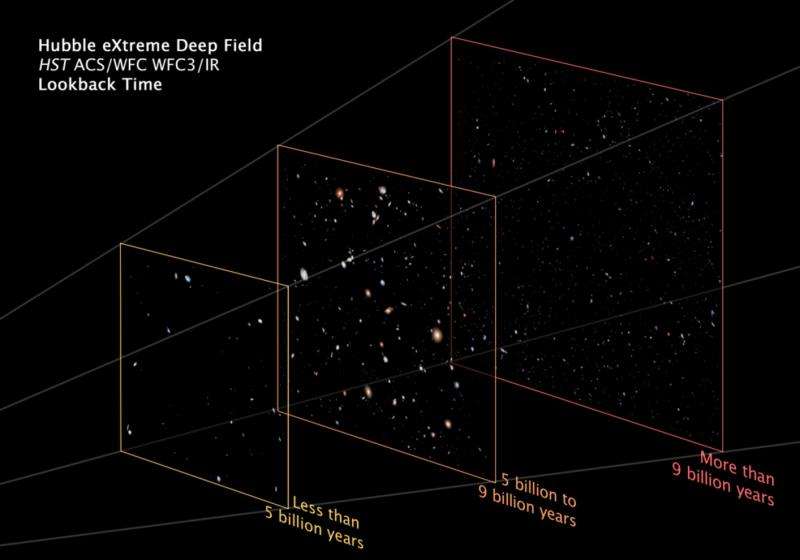
A handful of the objects in the image are comparatively "nearby" foreground stars in our own galaxy located perhaps a few tens or hundreds of light-years away. Although the field was chosen to have few of these, some faint stars are present. The stars are quite easy to identify due to the diffraction spikes caused by Hubble's optics – the tell-tale cross of light across their centre. All the other objects in the image are galaxies.
The image acts a little like a time machine. The further away a galaxy is, the longer it has taken light to reach us – and the earlier in the universe we are looking. Since that light was emitted the universe has continued to expand. Some galaxies in the picture lie close to the edge of the observable universe. This is the furthest point in space to which we could, in principle, see. This is about 45 billion light years from the Earth: light from more distant objects has not yet had time to reach us.
Far away and long, long ago
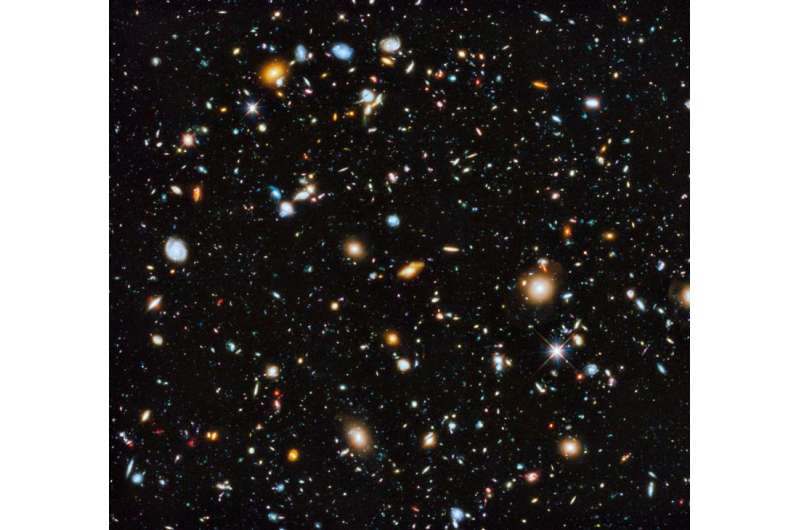
Some of these galaxies are comparatively near by, perhaps a few hundreds of millions of light years away. These are the bigger objects in the picture: blue or white galaxies with sharply-focused spiral arms, or large red and orange blurs. Galaxies like this are very similar to galaxies we see near the Milky Way.
The most distant objects look very different to galaxies nearer to us, tracing how rapidly galaxies change in the early universe. They shine brightly with the light of young stars, revealing that more stars are formed in the early universe than previously thought.
One of these objects, dubbed 39546284 in the zoomed picture above, is thought to be the most distant: it has taken light about 13.3 billion years to reach us (the universe itself is thought to be about 13.7 billion years old). Many of these very young galaxies will eventually evolve into galaxies that look more like the Milky Way.
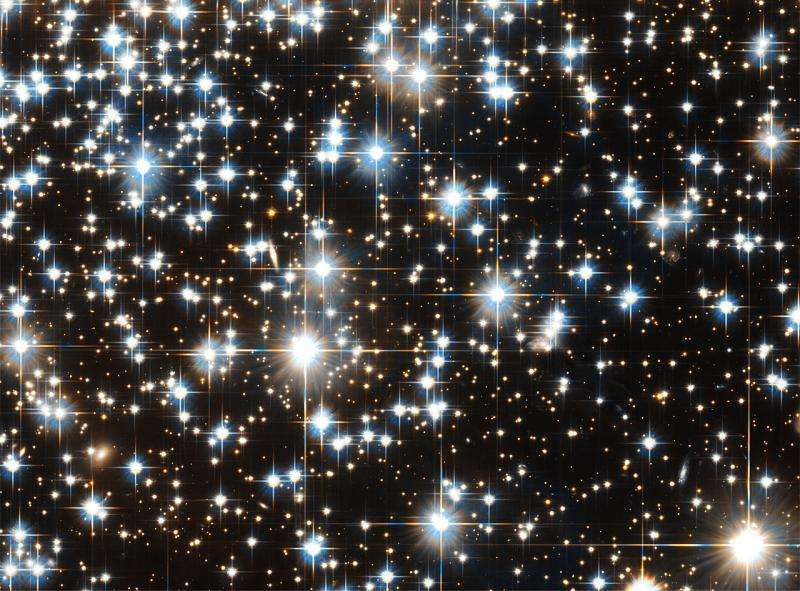
The image also contains a few supernovae, exploding stars detected more than halfway across the universe. SN Primo is one of these, nearly ten billion light years away. Supernovae like these are being used to map out the expansion history of the universe.
Perhaps the most remarkable fact is that this image represents just a tiny fraction of our universe. All told, there are estimated to be some 100 to 200 billion galaxies in the universe, of which only just over 5,000 appear in the HXDF. Put another way, you'd need about 30m images like the HXDF to map the entire sky.
This remarkable image will be one of Hubble's lasting legacies. With the Space Shuttle now retired from service, there are no future servicing missions planned. This means no future instrument upgrades, so it's unlikely that Hubble will ever be able to improve significantly on the depth of this image. That honour may await the James Webb Space Telescope, scheduled for launch in 2018, and the beginning of another astronomical legacy.
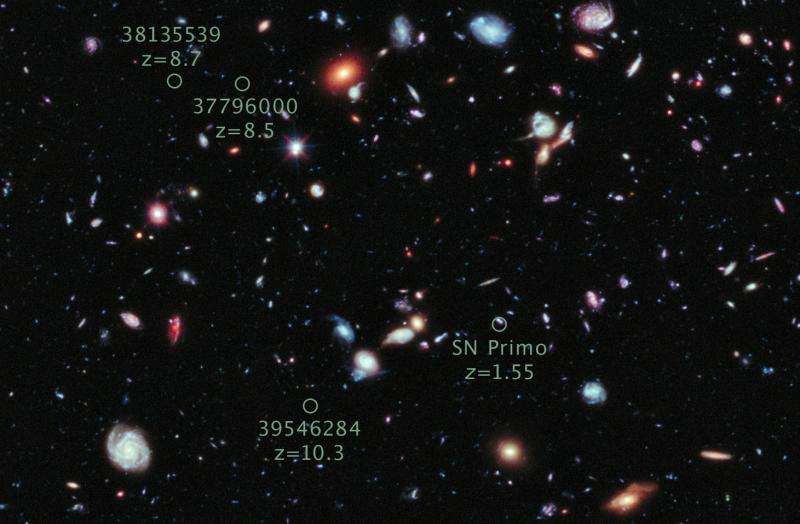
Source: The Conversation
This story is published courtesy of The Conversation (under Creative Commons-Attribution/No derivatives).
![]()





















